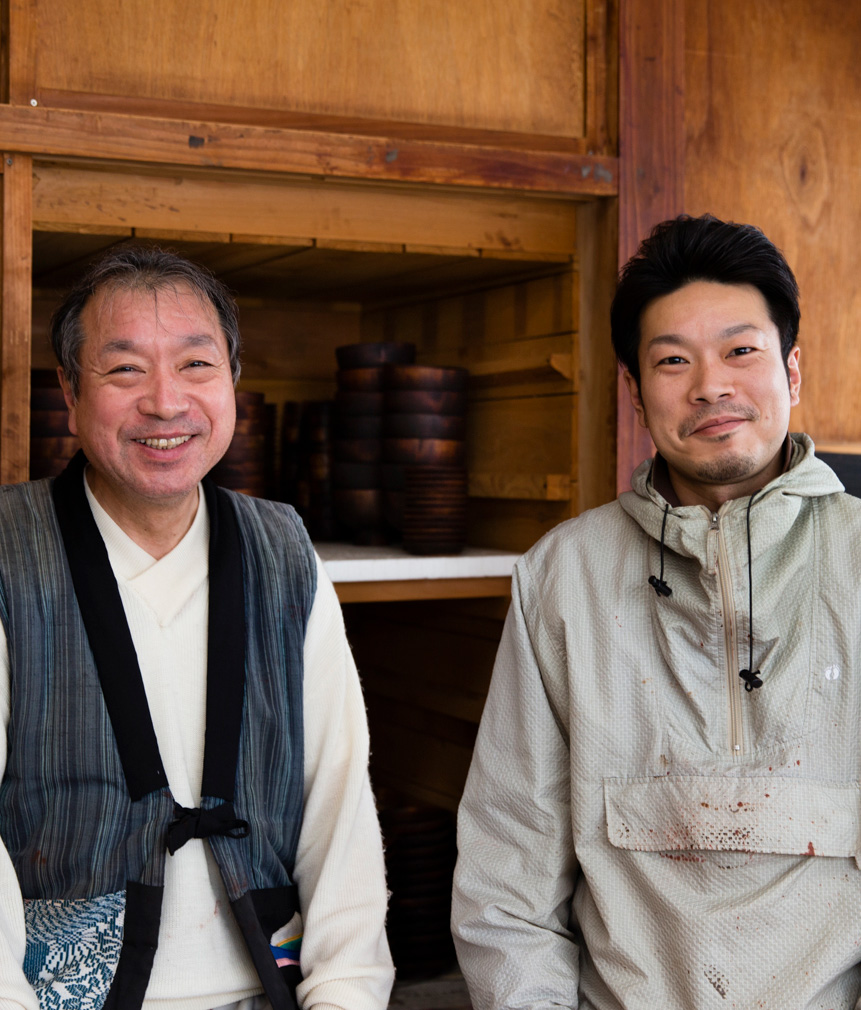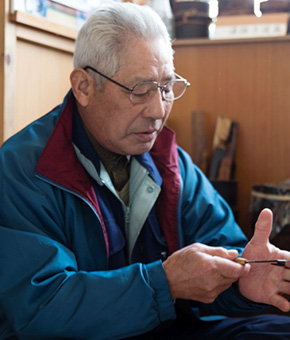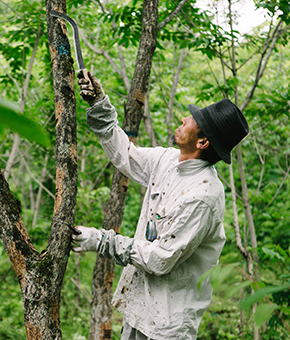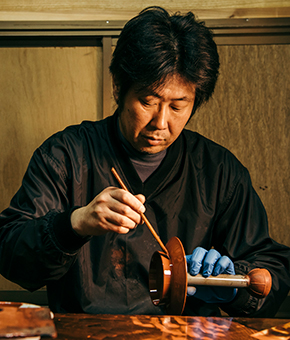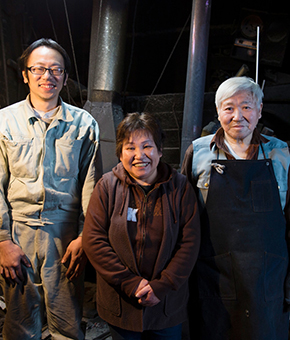Worship the gods of mountain
Urushi tapper Mr. Takeo Kudo
Professional with career over 60 years
More than two decades ago, “Japan urushi tapping Preservation Society” was launched in Joboji. Takeo Kudo, the current chairman of the society, is a craftsman for urushi tapping for 2 generations. Learning the techniques from his father, his career has now been more than 60 years. “They still let me do this only because I have been doing this for a long time. But I actually think you don’t know anything about the trees until you tap it for at least 20 years.” He laughs.
The Beautiful Work Takes Great Urushi.
In this area, Urushi tapper goes into the mountains at the beginning of the raining season (around 11th of June). Before entering the mountain, Sake for God, salt, and two fish such as Ayu sweetfish with the head are dedicated in a tray of red inside and black outside. Furthermore, “Arrange the tools in the work hut to make prayers for the gods of the mountains.” Then you go ask them, “I will tap how many hundreds this year.” And then, spray some salt in the woods of the Urushi. Once the lacquer-tapping of the year is complete, thank gods in the hut.
Looking back, he used to just scratch the tree. His father had artisan spirit, and never taught any techniques of the lacquer-tapping. What he did teach him was how to make the tools, and only the very basic, “to not stop and keep on tapping, take as fast as possible and not to waste any lacquer.” What he can rely on is his own experience. “It’s the same way in how to use the tools. You have to rack your brains in many ways. I used some of the trees to tap that year for research. I tried different strokes and took some data like measuring with a ruler. Now the trainees for urushi tapping are more required to take as much volume as possible, so they may not have time for something like this.”
Experience makes tapping technology
Now, only a few notes are taken on the calendar, but we used to write a daily report for about 30 years. Three years of record is about a notebook. We used to keep how much we took on the mountain that day. And, we have to get more than the previous day, making sure the yield increases every day. Urushi is considered a natural grace and seems impossible to control, but Mr. Kudo insists “it is possible to control.”
This confidence is backed by his answer that he found. If your master doesn’t teach you, you have to think yourself. Try it. Record it. And his actions have been decided. Prepare different types of tools that match the properties of the trees, such as trees with thick bark, thick trunk, or the ones on a slope beside the fields. Also, make a detailed request to blacksmiths who make the tools.
In addition, Mr. Kudo goes around the mountains so that the time when he visits a point stays constant, to get the lacquer at the same timing. “The place I go in the morning, I would always go in the morning. Those I visit in the afternoon, I would always go in the afternoon, and I set the places like that. I kept this since my father was doing the job. According to him, this is because “If time or the climate change, then the theory of the mountains change.” You can tell the difference between the days because you always go under the same condition. The mountains do not care about your business. Humans always have to follow them. You take days off when it rains. Not because you can’t work in the rain. The Urushi will still come out, the rain washes it out, so you waste it, and the trees will be damaged. Even when it stops raining, he doesn’t go tapping until the trunk is dry.
The tools are made with blacksmith and yourself
“This part that is sticking out is the same as the guard of a sword. It is there, so you don’t cut your hands when you slip. There is a rule on how to shave the handle. I think anyone who practiced under the master would know this.” He showed us the tools of his precious urushi tapping. The blacksmith provides the metal parts of the tool, but the urushi tapper installs the “Handle.” Each shape of the tool has its meanings, such as the projection part of the sickle, bulging of the handle of the lacquer plane, so that the hand position stays fit. “If you use a new plane, it will not work. It’s too sharp. We give small detailed requests to the blacksmith, but the tool cannot be made only by them.”
Mr. Kudo makes a new lacquer plane every year. He tests the new plane in step called “Urame-kaki (back tapping),” which for a tree is its last time. This lets the tool get used to the tapping and makes the best condition for the busiest season, from late July to August in the following year where most Urushi is picked. Also keep a few of the old ones aside. Have a grindstone for each of the tool, and think about how to sharpen. This is how you use different tools according to trees.
A spatula “can be used for 10, or even 20 years.” The small spatula he used when he first entered the industry after middle school is now “used for tapping branches.” This jet black spatula has been supporting Mr. Kudo for 60 years.
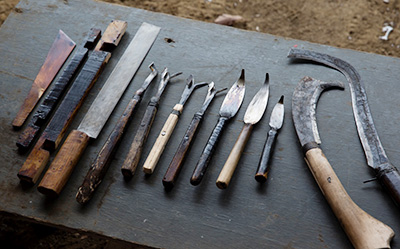
His favorite tools. From the right, plane to remove the bark, the hatchet to collect branches, and the spatula now smaller as used for 60 years. The spatula next to it is the regular size. He carries multiple lacquer planes. The gouging plane called “Eguri” with a large handle is used when the wood is hardening. Gonguri to scrape the bottom off Takappo (lacquer container), Kakego to scrape off the remaining lacquer into the barrel, and Kibera (wooden spatula) to scrape this lacquer off Gonguri at last, are all in good Urushi color after many years of using.
Takappo to place tapped lacquer is also handmade every year with the bark of a magnolia tree in his mountains. Actually, this Takappo is quite popular in the field of Wabisabi Japanese tea ceremony. The buyers will use this as a Shitsu, a vase for the flowers in the ceremony. When I took the black-shining Takappo, only the part of the tub rolled around. They look connected, but only the string will turn. This is another way he learned from his master. Showing us how to tie it, he said, “Most people just tie it as it is.”
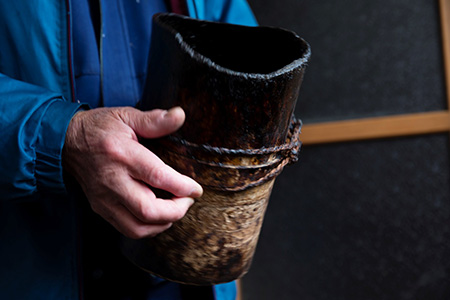
Takappo tinted in the color of lacquer is ideal to use for decorating the flowers in the tea ceremony.
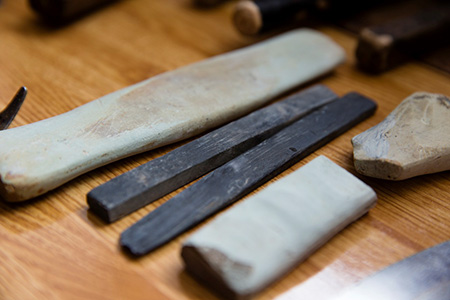
He has various kinds of grindstones in size, shape, and material, according to the tools.
If the trees grow, the urushi tappers also grow
Mr. Kudo’s current problem is the amount of Urushi wood. Mr. Kudo can estimate how much he can get from the trees. According to his calculation, he fears that the trees will run out. “Even if we have more urushi tappers, they will only waste the tree if they scratch the tree to only damage them and not get the lacquer. And we have people who grow the tree, and we can tap them from there, but the prices of the tree are the same regardless of the size if they are thick or thin (that the tappers would buy). In this case, the people who plant the trees won’t increase.” He is concerned about the future.
Mr. Kudo is also in the position to teach, and he has had 12 to 13 trainees so far. 3 to 4 of them are still training, and some of them signed up for the training system of Ninohe City. However, he says “They can get lacquer even if I teach them for a short period. But they can’t get good lacquer. It’s hard to explain with words, but the way you scratch the tree or how to use the spatula affects how good the lacquer will be. The way you scratch the trunk, and how you do it makes a difference in the glow and color of Urushi.”
If the lacquer plane is not inserted smoothly, there will be steps inside of a scratch. In that case, the spatula gets stuck. You will waste the lacquer. In the lacquer plane, there is a part called “Mesashi.” This is used to get a cut so that the lacquer would come out easily on top of the scratch made with the feather part of the plane. But if you don’t do it right, some transparent water will come out instead of the milky sap, and it will not stop. Then the tree dies. So “I say to do not use Mesashi often. You can get lacquer then, but it cuts down the circulation of the tree, and you won’t get any more. You will get better Urushi if you don’t use it.” He emphasized. The future challenge for Joboji is to improve the technology of tapping the lacquer without waste and setting the proper price of the tree that meets its value.
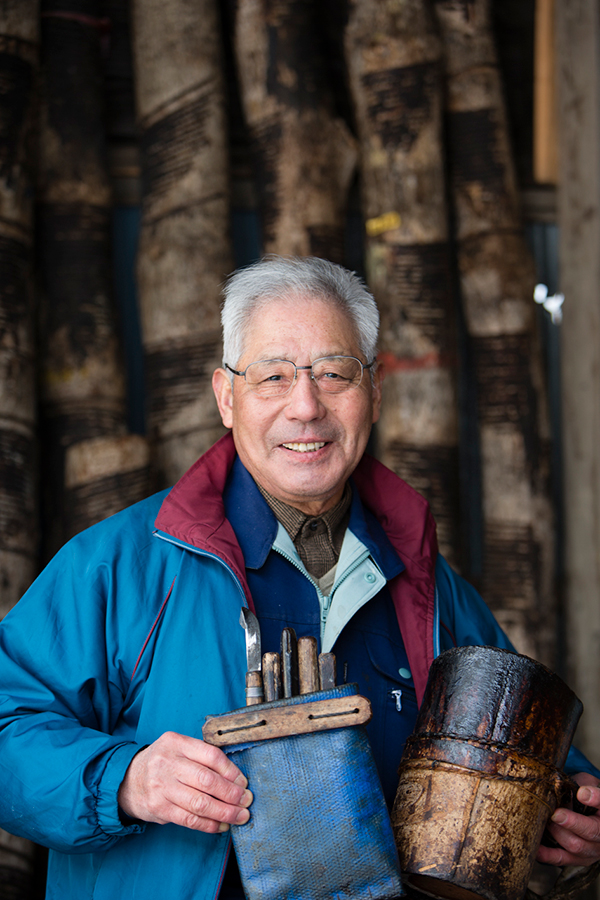
All tools – containers of the tools, Takappo, etc. – are handmade by the urushi tapper himself.
We saw some Urushi trees that have been tapped, outside the hut. Many of them belong to the trainees. When we looked at it, some lacquer tinted the trunk black, or some were too pale, the traces of the trees varied. “This white-ish scratch is the one I talked about, the clear water coming out. Actually, we could get more of it,” says Mr. Kudo, with slight disappointment. The marks (scratches) on the trunk are uneven. “If you are more into aligning your marks on the tree, the lacquer will also be better. You have to do a clean job in all steps. This is all about getting the good stuff.”
The trees Mr. Kudo tapped has a clear black line lined up. A beautiful piece of work with no waste was there.

